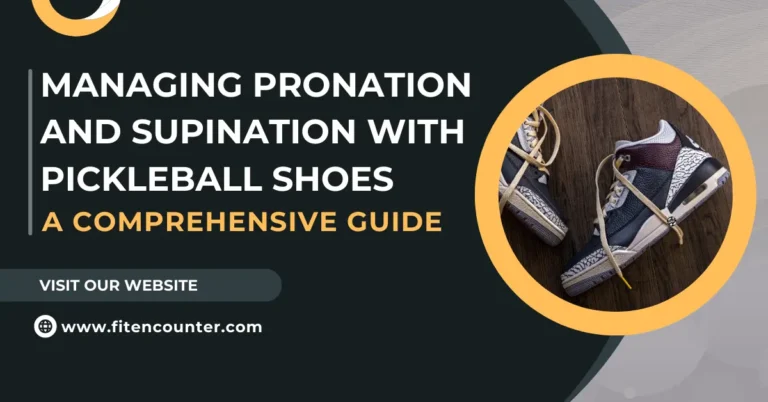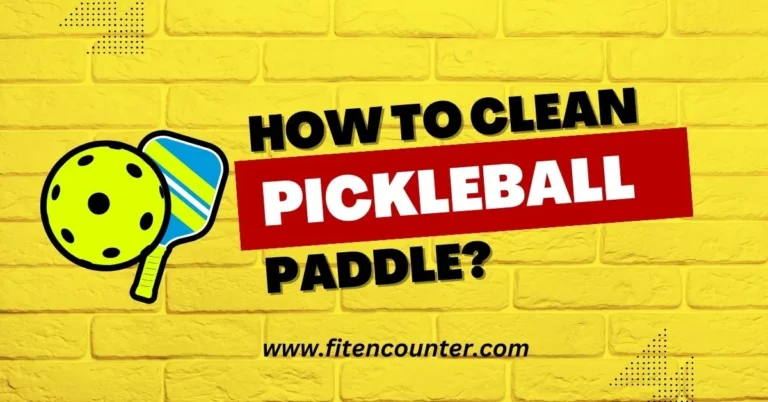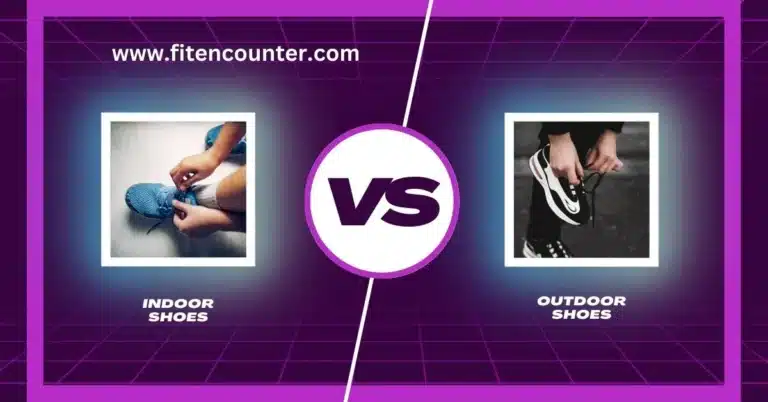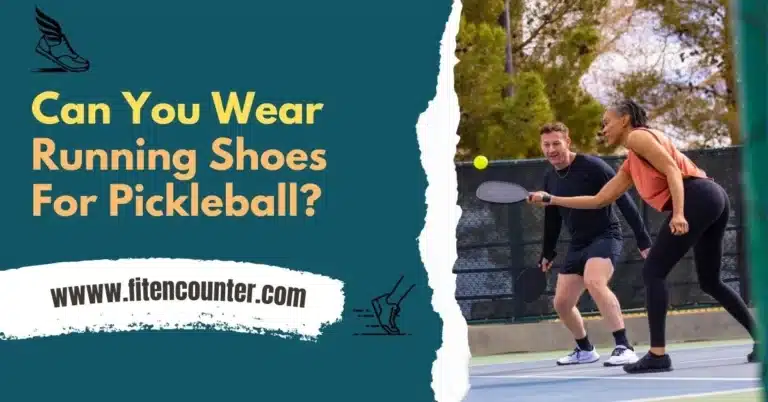How to Lace Up Pickleball Shoes Through unique Shoe lacing techniques
Imagine you are playing a pickleball game with full enthusiasm, and suddenly, your toes splay due to inappropriate lacing, and you miss an essential hit.
You can save your splaying toes by adopting the lacing off-center method and prevent heel spillage by trying the heel lock method. But when you explore it deeply, there are numerous other methods of lacing up pickleball shoes like the runner’s loop, bar lacing, straight bar lacing, and the list goes on for optimal support.
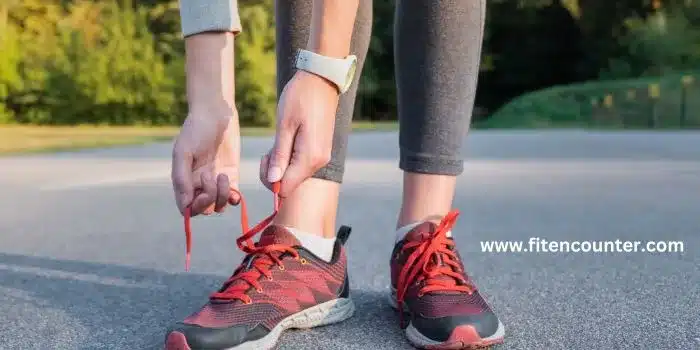
But do you know lacing up your shoes can greatly impact the pressure on your feet? If you need to learn how to lace up pickleball shoes properly, the tips and techniques, and their impact on your game performance, here is a complete guide.
Understanding the Importance of Shoe Lacing Techniques
Picking the right pickleball shoes is essential, but how you lace them up also matters. Different lacing styles give your feet a decent amount of comfort, movement, and support. Several popular lacing techniques exist, but three styles are the most common among players.
Each lacing method has its unique advantages and disadvantages. Consider factors like your play style, foot issues structure, and support needs when deciding which works best for your pickleball footwear.
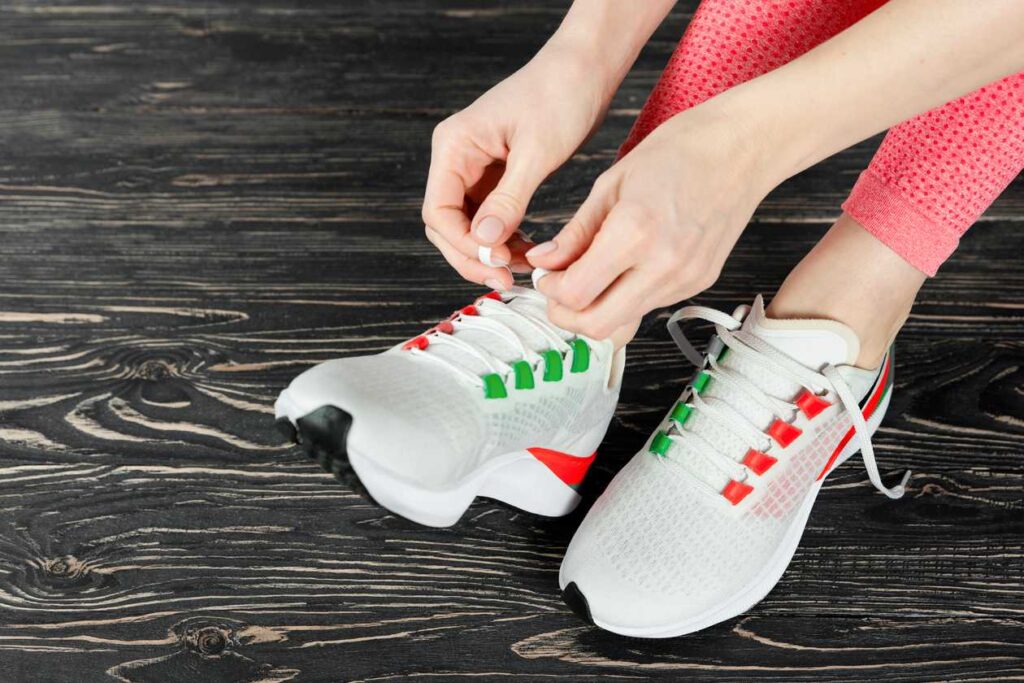
What Are the Main Concerns With Pickleball Shoe Lacing?
When lacing up their pickleball shoes, players are primarily concerned with getting the right fit for their foot shape, playing style, and orthopedic issues. The primary considerations are:
The good news is many different lacing techniques allow you to customize the fit of your pickleball shoes and address these concerns.
How to Lace Up Pickleball Shoes Using Various Techniques for Different Needs
Proper shoe lacing technique is vital to getting the right fit for your foot when playing pickleball. How you thread and tie the laces can make a big difference in comfort, stability, and preventing injury during quick stops and stops on the court. Numerous techniques can assist with problems ranging from heel slippage to pressure reduction. Let’s explore them in detail:
Preventing Heel Slippage
When you experience heel slippage in your shoes, it can lead to painful blisters and loss of stability on the court. Before you play, you’ll want to ensure your heel is adequately secured. To avoid this scenario, try these lacing techniques:
- Heel lock
In this technique, you must wrap laces around the ankle for a locked-in rear foot. This method is suitable for narrow heels. The contestant can feasibly discern their heel and ankle feeling secure and stable, with no slipping or movement within the shoe due to the laces wrapping around the ankle, locking the rearfoot in place.
- Runner’s loop
Using this procedure, you need to create loops near lower eyelets to lock down the heel, which works well for moderate heel slip. The athlete will probably sense their heel locked in place without slipping or rubbing, providing a more secure and comfortable fit in the shoe.
Supporting Arches and Midfoot
All Pickleball players have different sizes of arches. Some have low, and others have high arches. To accommodate them, there is a need for extra midfoot support. These methods can help in that regard:
- Bar lacing
In this method, we must skip eyelets in a bar pattern to add lace tension across the midfoot arch area. Ultimately, you will likely feel your arches being hugged and supported by the added tension, providing a secure and stable midfoot feel while playing.
- Straight bar lacing
This criss-cross lacing avoids arch eyelets to pull the midfoot back. So, the stability is maintained while playing. The gamer may comprehend that their foot is held securely in the shoe with good arch support, as the lacing method locks the midfoot in place for stability during activity.
Accommodating Wide Feet
If you are among those pickleball players with wide or square-shaped feet, they need a broader lacing pattern. Consider the following ways of lacing techniques:
- Straight lacing
It is the basic criss-cross pattern with no skipped eyelets. The participant may detect a snug, secure fit as the laces tighten the shoe closely across the foot in the traditional criss-cross style.
- Ladder lacing
In this lacing style, you must create two parallel laces without criss-crossing for maximum wide fit. It is a more popular pattern of lacing for those with wide feet. You will likely feel their feet fitting more comfortably in the shoe as the parallel laces provide a broader base without constriction.
Relieving Pressure on Bunions and Toes
Bunions and wonky toes put up with enough abuse on the court – give them a break by lacing for maximum comfort. To gain relief from bunion pain and make your toes cramped, Try:
- Asymmetrical lacing
In this process, you must skip medial eyelets to reduce lace pressure on the bunion side. Any sportsman would probably grasp relief as the pressure is lessened on the bunion area.
- Lacing off center
This lacing technique allows you to line up more medially to give toes more room to spread. As a pickleball player, you will likely feel more comfortable and less restricted as your toes have more space to move naturally.
Other Lacing Tips and Tricks
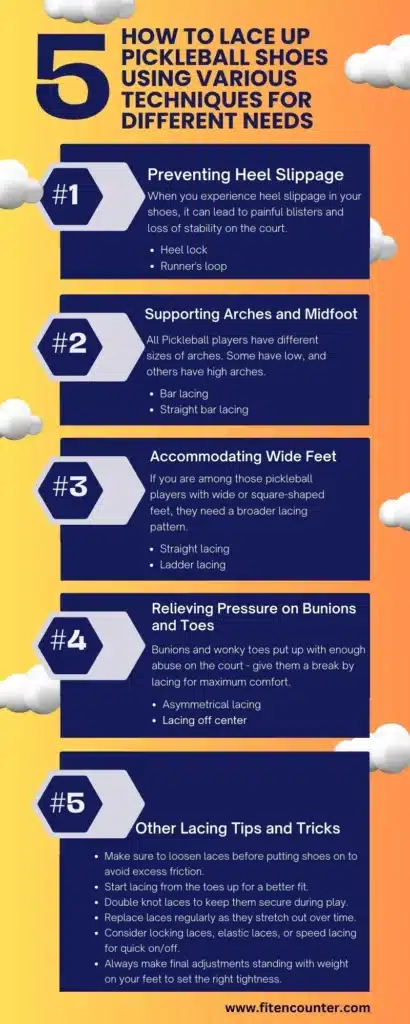
Finding Your Perfect Lacing Method
Different lace patterns are suitable for different situations. The optimal lacing technique depends on what provides you the most comfort. Each lace pattern has advantages and disadvantages, so choosing one can be tricky.
However, a cross-lacing pattern offers decent support and stability but may need to be more safe and can make your toes uncomfortable. On the other hand, a zig-zag or high arch pattern provides good ventilation and support. But, these patterns can be complex to lace up properly. High arch lacing can make shoes too tight and uncomfortable for some people.
What should you do? Try 2 or 3 different lace patterns (at least) when you play pickleball. This will aid in determining which design functions most effectively for you. Also, consider whether you play mostly indoors or outdoors, as this can influence the ideal lacing pattern. To find the optimal lacing method, test different ways and evaluate how each one feels during athletic activity.
Trial and Error Method
Finding your perfect lacing pattern takes some trial and error. Follow this process to dial in your ideal lace-up approach:
Be patient. Your perfect lacing method is out there. Test, analyze, and refine until you find the lace-up pattern that optimizes your pickleball shoe performance and enjoyment.
Final Thoughts on Lace-up techniques of pickleball shoes
Proper lace-up technique for your pickleball shoes is vital to maximizing your foot health, comfort, and performance on the court. By dialing in the ideal lacing method for your foot type and playing style, you can reduce pain, prevent injury, stabilize your movement, and elevate your game.
Experiment with different lacing patterns like the heel lock, runner’s loop, straight bar lacing, or asymmetrical lacing to address your specific needs. Fine-tune the fit and tension during active play until you find your customized sweet spot. Optimizing the lacing system of your pickleball shoes gives you the foundation necessary to compete at your highest level.
Frequently Asked Questions
What is the best lacing technique for pickleball shoes?
The best lacing method depends on your foot shape, standard foot issues, and comfort needs. Those with heel slippage may benefit from heel lock lacing. People with bunions can try asymmetrical lacing. Wide feet do well with straight lacing.
How tight should I lace my pickleball shoes?
Lace tension should be snug but not overly tight. Make final adjustments while standing with weight on your feet. The shoes should hug the foot without constricting circulation or movement.
Where should pickleball shoe laces align?
Most shoes lace up center, but people with bunions or toe issues may lace slightly off-center. Lacing too far medially or laterally can cause discomfort.
Can I use locking laces for pickleball shoes?
Many players use locking, elastic, or speed lacing systems for pickleball shoes to allow quick on and off. These are tournament legal.
Should I double knot my pickleball shoe laces?
Double knotting is recommended to keep the laces securely tied throughout active play. Single knots may come undone.


